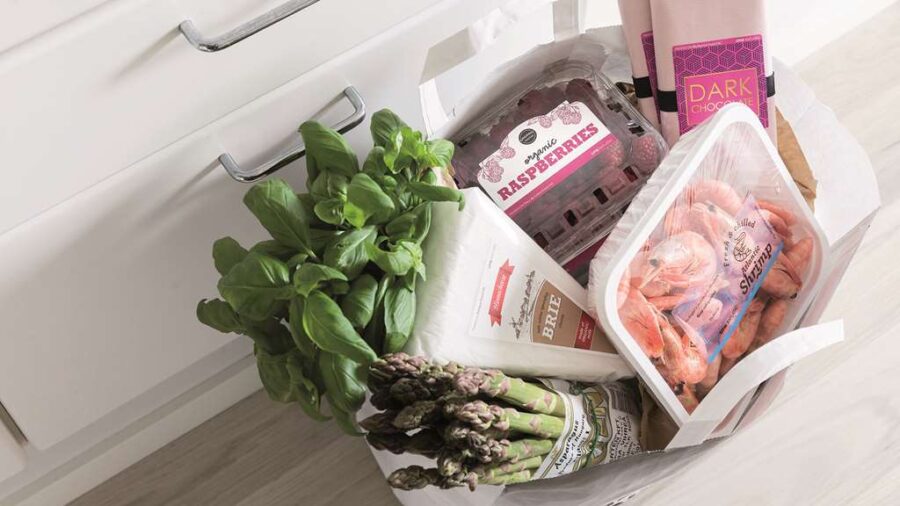Restaurants, grocers and meal delivery services prioritize tamper proof seals, pressure and temperature-sensitive design, increased traceability, waste reduction and responsible sourcing
MILLS RIVER, NC — As U.S. consumers turned to takeout, food delivery and online grocery shopping during the COVID-19 pandemic, food and beverage labeling took on fresh importance. Citing a 15-20% increase in grocery industry sales this year, and e-commerce sales up 43%, sustainable label leader UPM Raflatac found its grocery and restaurant delivery customers want to provide an increasingly safe experience with labels that provide visible safeguards for human health and protections for the environment.
“We knew packaging needs would change for our food industry customers given the COVID-19 shopping impact, and we are encouraged to see that sustainability has not taken a backseat,” said Kyle Strenski, Business Director (Food, HPC and Beverage) for UPM Raflatac Americas. “In fact, our 2021 order data shows that sustainable features for food labels are even more important now, as consumers and customers prioritize a more transparent and safe food system. Sustainability does not have to be sacrificed for safety or convenience.”
Based on UPM Raflatac’s customer insights and requests, Strenski identified the top food label and packaging trends for 2021:
1. Tamper-Proof Labels for Contactless Food Delivery Containers, Pizza Boxes and More
With meal takeout and grocery delivery increasing approximately 75% during the pandemic and spending on meal delivery services increasing 70% this March compared to 2019, food packaging has become a critical tool for retailers and producers to communicate health and safety practices.
Traditionally favored for pharmaceutical and high-value electronics, tamper-proof labels now provide restaurants, grocers and meal delivery service customers visible proof of responsible handling from preparation to delivery. According to UPM’s Strenski, all major national food delivery companies and many national food and quick service restaurant chains are now using pressure sensitive labels on food packaging, with some restaurant customers, including Papa John’s, advertising the packaging to emphasize a commitment to human health, safety and quality.
2. Smart Labels Improve Food Safety, Traceability and Inventory Management
Food safety remains paramount for food producers, and U.S. regulators are calling on companies to maintain updated, digital data systems for tracing ingredients, vendor supplies, and inventory throughout the production process. High-tech QR codes and tracking data on shipping and transport labels for food items and supplies help improve inventory management, traceability and a faster response to potential food supply and system issues.
3. Food Safety Security
In an age of frequent and highly publicized food recalls and food security concerns (such as Salmonella in onions and fresh produce or foreign particle contamination), QR codes and data tracking on food labels help quickly trace supply chains, vendors, retail destinations and lot codes. Temperature-sensitive thermochromic ink will alert retailers, producers and consumers if a material intended to be cold was outside of acceptable temperatures during transport, delivery or storage. The more data to ensure product quality and safety, the higher the confidence of retailers and grocery customers.
4. Increasing Sustainability While Maintaining High Quality Performance
Consumer packaged goods and retailers have committed to an average of 25% recycled content in their plastic packaging by 2025. While a label may account for only 2% of a plastic package’s weight, it can be the deciding factor in whether or not the material is recyclable. In the rush to meet an overwhelming shift to e-commerce and food delivery during COVID-19, some packaging details, including adhesives, ink integrity or label wrappers, have been overlooked. Take ink quality or clarity on a delivery receipt or seal that is not temperature resistant: hot temperatures may cause some inks to smudge illegibly, impeding actual delivery, storage or quality. Safety can also be impacted by materials choices: Reusable Plastic Containers (RPCs) often used by food producers to transport farm materials (bulk fruits/vegetables/seafood/meats) contain durable labels that must be washed off prior to their next use. The adhesive must separate cleanly to prevent potential exposure to bacteria. Or consider sustainable labels that still contain non-recyclable plastic backing. UPM Raflatac offers sustainable options that reduce waste in every stage of packaging. These performance details are the focus of new generation labels designed with sustainability in mind at every function of the packaging process.
# # #
About UPM Raflatac
UPM Raflatac is leading in sustainable labeling through their innovative self-adhesive label materials and services. They offer high-quality paper and film label stock for branding and promotion, informational labels, and labels with functionality. They operate a global network of factories, distribution terminals and sales offices. With its Americas headquarters in Mills River, North Carolina, all three UPM Raflatac production sites in the United States are 100% powered by renewable electricity. The company employs approximately 3,000 people and achieved sales of EUR 1.6 billion (USD 1.8 billion) in 2019. UPM Raflatac is part of UPM. Find out more at www.upmraflatac.com.
Contact:
Fineman PR for UPM Raflatac
415-326-3199
media@finemanpr.com
